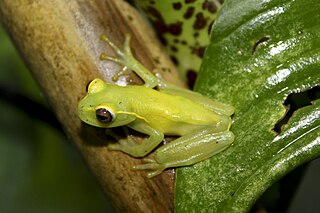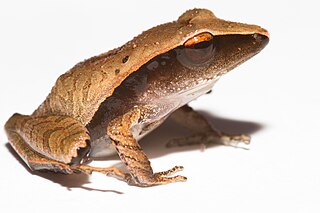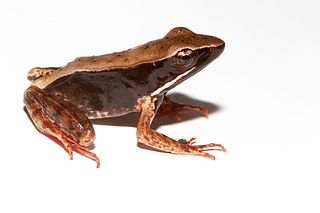
Cochranella euknemos, sometimes known as the San Jose Cochran frog, is a species of frog in the family Centrolenidae. It is found in central Costa Rica and south/eastward to Panama and to the western flank of the Cordillera Occidental in Colombia. Some Colombian records might apply to Cochranella mache.
Silverstoneia nubicola is a species of frog in the family Dendrobatidae. It is found in western Colombia, Panama, and southwestern Costa Rica.

The La Loma tree frog is a species of frog in the family Hylidae found in Costa Rica, Panama, and expected but not confirmed in Colombia. Its natural habitats are tropical moist lowland and montane forests, with breeding taking place in streams. It is threatened by habitat loss and chytridiomycosis.
Isthmohyla debilis is a rare species of frog in the family Hylidae. It occurs in the Atlantic slopes of the Cordillera Central and Cordillera Talamanca in Costa Rica and western Panama as well as on the Pacific slopes in southwestern Panama. Common name Isla Bonita treefrog has been suggested for it.
Craugastor andi is a species of rain frog in the family Craugastoridae which has not been seen since 1990. It is found in the Caribbean drainage of Costa Rica in the mountains and hills of the Cordillera Central and the far northeastern Cordillera de Talamanca, and in extreme northwestern Panama. Frank and Ramus (1995) give it the vernacular name Atlantic robber frog. It is known locally in Spanish by the generic names, used for many species, of rana de hojarasca, ranita or sapito.
Craugastor catalinae is a species of frogs in the family Craugastoridae. It is found in the Río Cotón drainage in the Pacific southwestern Costa Rica and on the Pacific slopes of Volcán Barú, western Panama. The specific name catalinae, rather obliquely, honors Karen R. Lips: Spanish name "Catalina" corresponds to Danish name "Karen". Lips collected a part of the type series and has "contributed substantially to our knowledge of the Río Cotón drainage herpetofauna and the declining amphibian populations problem in lower Central America."
Craugastor emcelae is a species of frog in the family Craugastoridae. It is found in Panama and possibly Costa Rica. Its natural habitats are subtropical or tropical moist lowland forests and subtropical or tropical moist montane forests. It is threatened by habitat loss.
Craugastor fleischmanni is a species of frog in the family Craugastoridae. It is endemic to Costa Rica where it has been found on the Meseta Central Oriental and Occidental, the Pacific slopes of the Barva and Poás Volcanos, the Atlantic slopes of the Irazú and Turrialba Volcanos, and on the Cordillera de Talamanca. Common name Fleischmann's robber frog has been suggested for this species.

Craugastor gollmeri is a species of frog in the family Craugastoridae. It is found in Costa Rica and Panama. Its natural habitats are subtropical or tropical moist lowland forests, subtropical or tropical moist montane forests, rural gardens, and heavily degraded former forest. It is threatened by habitat loss.
Craugastor gulosus is a species of frog in the family Craugastoridae. It is found in Costa Rica and Panama. Its natural habitat is subtropical or tropical moist montane forests. It is threatened by habitat loss.

Craugastor mimus is a species of frog in the family Craugastoridae. It is found in lowland and premontane forests on the Atlantic versant from eastern Honduras through eastern Nicaragua to central Costa Rica. Its natural habitat is lowland and premontane moist and wet forests. It is threatened by habitat loss.
Craugastor obesus is a species of frog in the family Craugastoridae. It is found in the Caribbean slopes of southeastern Costa Rica and western Panama. Its natural habitats are lowland moist forest, premontane and lower montane wet forest and rainforest. It can be found in the spray zone on rocks, boulders, and cliff faces in the middle of moderate-sized cascading streams.
Craugastor persimilis is a species of frog in the family Craugastoridae. It is found in the lowlands and premontane Atlantic slopes of central to southeastern Costa Rica. Its natural habitats are lowland and premontane moist rainforest. It lives in leaf-litter and can persist in moderately disturbed areas, including plantations. It is an adaptable species that is not considered threatened, despite severe habitat fragmentation within its range.
Craugastor ranoides is a species of frog in the family Craugastoridae. It is found in the southern Atlantic lowland of Nicaragua and northwestern Costa Rica, and through Costa Rica to extreme western Panama. Its natural habitats are, principally, lowland and premontane wet forests in association with small streams, but also dry forests with perennial streams. It is threatened by habitat loss and chytridiomycosis. The species has disappeared from much of its former range in Costa Rica, also in pristine habitats, possibly because of chytridiomycosis.
Craugastor rayo, also known as the Sabana robber frog, is a species of frog in the family Craugastoridae. It is endemic to the Cordillera de Talamanca, Costa Rica.
Craugastor rhyacobatrachus is a species of frogs in the family Craugastoridae. It is found in the Pacific slopes of the Talamanca-Barú Massif of Costa Rica and western Panama. The specific name rhyacobatrachus is derived from Greek batrachos and rhyaco ("torrent"), in reference to the torrential streams that this species inhabits.
Craugastor rugosus is a species of rain frog in the family Craugastoridae. It is found in Costa Rica and southwestern Panama, and possibly southern Nicaragua.
Craugastor talamancae is a species of frog in the family Craugastoridae. It is found in the Atlantic versant of Panama, Costa Rica, and southeastern Nicaragua. Common name Almirante robber frog has been proposed for it.
Lithobates vibicarius, commonly known as either green-eyed frog or Rancho Redondo frog, is a species of frog in the family Ranidae from highland rainforests in Costa Rica and western Panama.

Warszewitsch's frog is a species of frog in the family Ranidae found in Honduras, Nicaragua, Costa Rica, and Panama.







